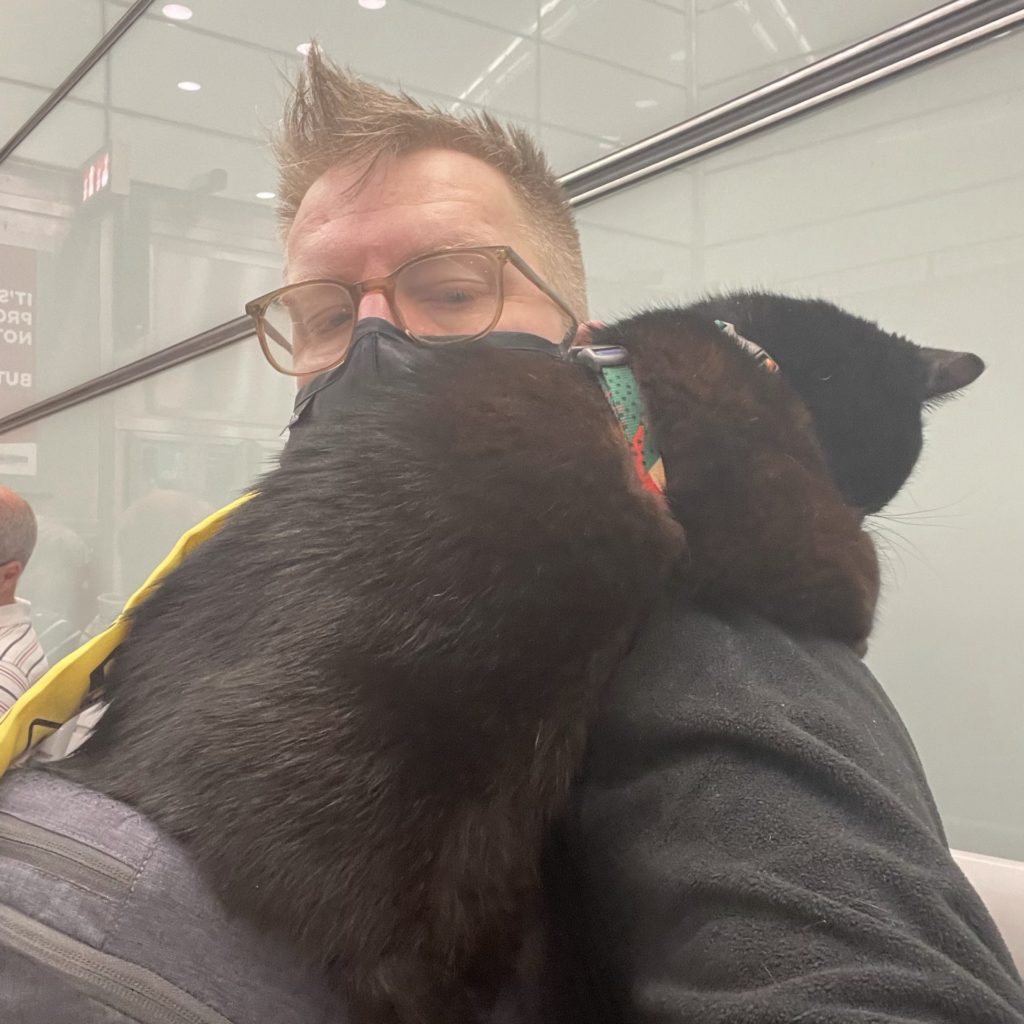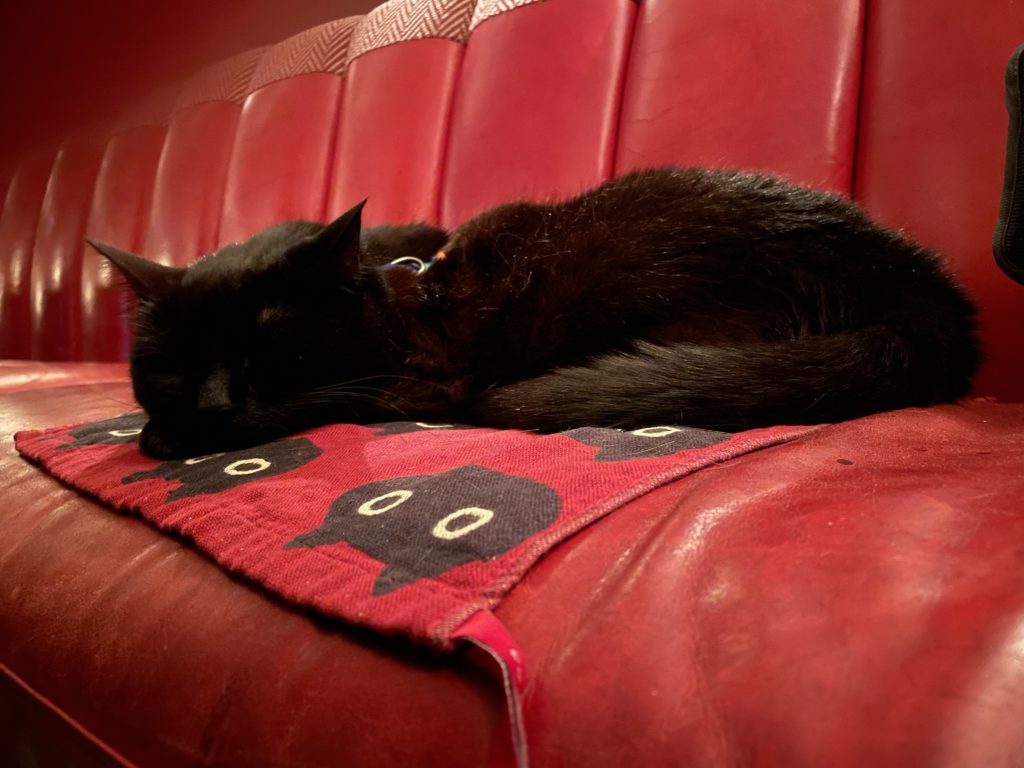When you consider that an autistic’s biggest challenges are away from home where they have less control over the environment and interaction, it makes sense for them to be accompanied by their assistance animal when out and about.
All bonafide autism assistance dogs meet a minimum standard for public access. Charity members of Assistance Dogs UK apply their own tests. Charities that help owners train their own dogs often recommend passing every level of the Kennel Club’s Good Citizen Dog Scheme. Unfortunately, there is nothing comparable for assistance cats. So, I have based the following on existing dog expectations and four years of working with Chloe. In doing so, I have tried to learn from the established dog standard but adjust for cat behaviour.
As Chloe only walks on a leash close to home and is carried everywhere else, I have not included on-leash walking behaviour. If you intend to walk your cat in a public situation, please consider adopting the Minimum Training Standards for Public Access from the International Association of Assistance Dog Partners.
General behaviour
- The cat is generally comfortable with all of the situations that it is placed into. Moderate stress is acceptable where it is normal for the situation, but a quick recovery is important. (Some people may question this, but cats generally, like humans, experience some stress. This is particularly true of outdoor cats in built-up areas where neighbourhood cats fight over territory. In the worst situations, a cat may show signs of stress including hiding indoors, and urinating or defecating inside the home but outside of their litter tray.)
- The cat is trained to use their litter tray before leaving the house, to reduce the likelihood of accidents.
Control
- The cat should be able to respond to the handler with attention on cue.
In the handler’s arms
- While in the handler’s arms, the cat does not struggle or fight to escape. The handler can control their cat and demonstrates an ability to help the cat quickly settle into new situations.
- If there is a loud noise, the cat is allowed to move position, for example, from one shoulder to another, but they should not flee.

Seated on a towel or lap
As dogs occupy the floor and owners aren’t always attentive, the ground is not safe for a cat. Instead, place the cat on a seat covered with a towel or similar barrier. From this position, they will feel safe and in control.
- The cat must sit or lie on the towel peacefully. It is allowed to change positions and move on top of the towel, so long as it is not disruptive, struggling to leave, or trying to closely investigate or visit another person, object, or animal.
- The cat is allowed to notice goings-on, but should not actively respond to them.
- The cat should not groom themselves excessively.
Public transport and vehicles
- On public transport or in vehicles, the cat should sit or lie peacefully on a lap or towel.

Shops, cafes and restaurants
- Whether in the handler’s arms or sitting on a towel, the cat at does not beg or attempt to eat or closely sniff at any food.
- The cat is not on a table, does not attempt to climb onto the table, and the handler does not feed or water their cat from the table.

Dogs
- On seeing a dog, it is acceptable if the cat freezes and displays a degree of apprehension, including climbing into the handler’s arms. It is not acceptable for the cat to react with aggression.
People
- If a person the cat doesn’t know attempts to interact with it without the handler’s permission, the cat is allowed to audibly complain to their handler or move away within their seating area. However, the cat should not react aggressively.
Inappropriate conduct
The cat must not display any inappropriate behaviours:
- Scratching or biting.
- Acting aggressively at other people or dogs.
- Being out of the handler’s control.
- Inappropriately urinating or defecating.
References
- Minimum Training Standards for Public Access (International Association of Assistance Dog Partners)
- Public access standard (mindDog) [PDF]
- Good Citizen Dog Scheme (The Kennel Club)
- How to pick up a cat like a pro – Vet advice on cat handling (Helpful Vancouver Vet) [YouTube]
- Is it ok to carry a cat like a baby? (Helpful Vancouver Vet) [YouTube]
Further reading
- How to Carry a Cat (wikiHow)
- How to hold a cat (Lifehacker)
- Should you take your cat out on a lead? (The Guardian)
- The RSPCA isn’t impressed with you walking your cats on leads, guys (Metro)
- Yes, you should walk your cat (New York Times)
- Why All Cats Should Be Indoor Cats (PETA)
- 5 tips on leash-training your cat (PETA)
- How To Harness Train A Cat To Walk On A Lead (Cat Behaviourist)
- Should You Leash Walk Your Cat? (Jackson Galaxy)
- Train your cat to walk on a leash (Adventure Cats)
- Cat: Leash training (San Francisco SPCA) [PDF]
- How to Leash Train a Cat (wikiHow)
- Leash Training Your Indoor Cat (Pam Johnson-Bennett)
- How to train a therapy cat (wikiHow)
